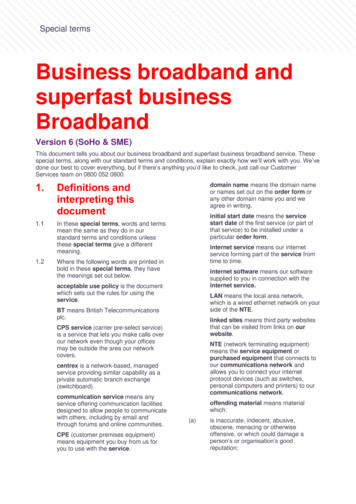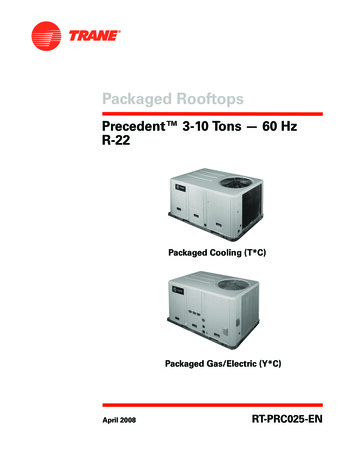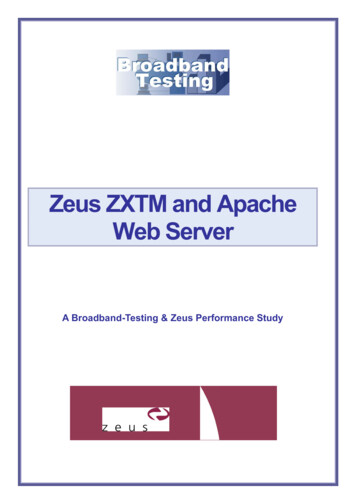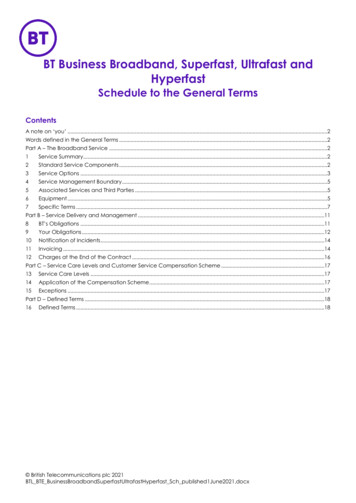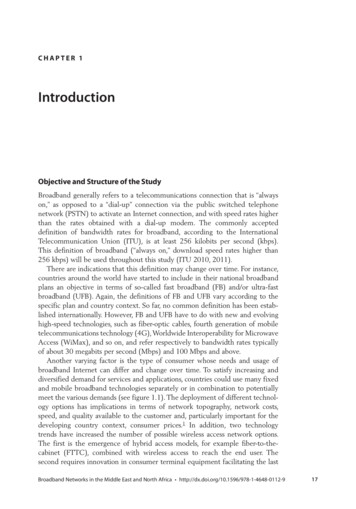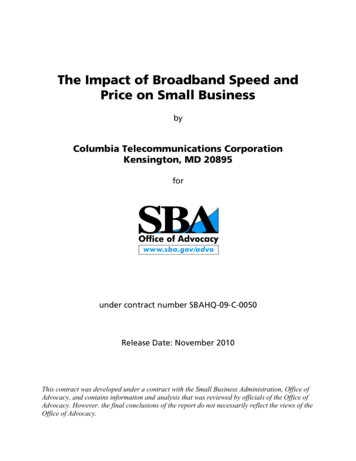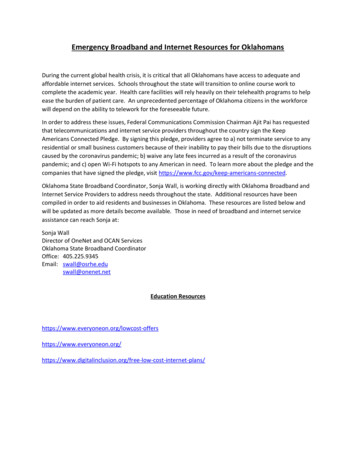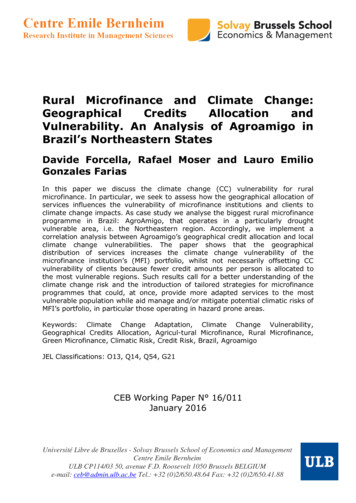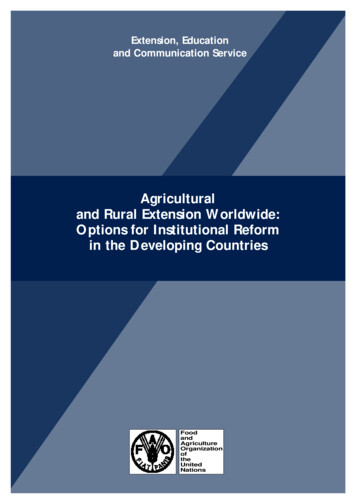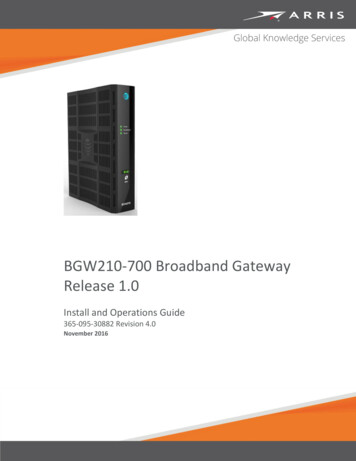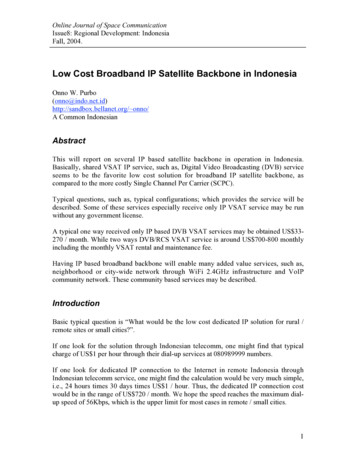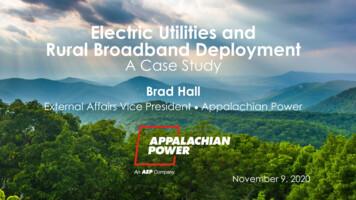
Transcription
Electric Utilities andRural Broadband DeploymentA Case StudyBrad HallExternal Affairs Vice President Appalachian PowerNovember 9, 2020
Appalachian Powera wholly-owned subsidiary of American Electric PowerCustomers1 millionGeneration8,700 MWEmployees3,000Revenue 3 billionNet Income 311 million
Rural Broadband Work in West VirginiaLogan-Mingo County Pilot Project March 2019: Senate Bill 3 passed allowing electricutilities to submit broadband feasibility studies Oct. 2019: feasibility study filed with W.Va. BroadbandEnhancement Council; approved Dec. 2019 June 2020: House Bill 4619 enables electric utilities to developbroadband infrastructure as regulated by the W.Va. PSC Approximately 20,000 electric meters in Logan, 15,000in Mingo, both with significant areas below 25/3Proposed Broadband Fiber RouteExisting Fiber Project includes up to 400 fiber miles, potential 50 millioncapital investment; utilizes up to 200 miles of existing fiber ISP selected in September 2020, GigaBeam Networks Scheduled to file case with PSC by end of 2020
Solving the puzzle iscomplex and different in each state West Virginia got approval and feasibility study in two pieces of legislation VA needed 3 bills over 2 legislative sessions before work on VA pilot could begin in WV, the ISP needed to be selected through an RFP as part of the project Grayson County VA performed its own RFP for a last-mile ISP prior to the pilot start Competing interests can hobble legislation – cable/telecom interests sought to restrictfocus of legislation to unserved residents and businesses Unserved customer speed definition Highlights need to define our purpose and intentions to build middle-mile, not be aservice provider Dual purpose (Grid Modernization and Broadband) makes project more attractive Work with supportive local, state and federal officials West Virginia project advisory committee includes W.Va. Broadband EnhancementCouncil, as well as county, regional and W.Va. PSC representatives
Electric utilities are uniquelypositioned to deploy middle mile fiber Fiber can provide benefits specific to electric service reliability Advanced Metering Infrastructure (AMI) Smart circuits Electric infrastructure penetration in rural areas is unparalleled Existing right of ways and electric distribution infrastructure 1930’s rural electrification program precedent Fiber infrastructure is a core competency of electric utilities AEP owns and operates more than 21,000 miles of its own fiber optic infrastructure Fiber miles expanding each year to support grid modernization efforts Electric utilities can deploy fiber in the supply space; eliminate duplicate infrastructure A straightforward installation with no interferences from other pole attachments Dual use of fiber with electric utility customers means fiber needs to be available for use
To meet the moment,we need to be able to move fasterThe global pandemic highlights the critical nature of solving the rural broadband access issue.In Virginia we began work on enabling legislation in 2018. Solutions for moving faster include: Federal legislation that: Recognizes electric utilities can help speed broadband expansion in underserved areas Guards against the buildout of redundant systems that will drive up costs to consumers Provides grant opportunities specific to the middle mile Includes federal assistance to utility expansion of broadband commensurate to thetelecommunications companies Straightforward regulatory processes for broadband projects Program based rather than project based Define broadband costs Identifying unserved customers involves significant time and effort Improved accuracy of FCC maps to truly identify those who are unserved
Rural Broadband Work in VirginiaGrayson County Pilot Project Potential 17 million capital investment More than 200 miles of middle mile fiberLast mile to use both fiber-to-home, fixedwireless Grayson County has around 11,000electric meters Approximately 5,000 are considered unservedProposed Broadband Fiber RouteUnserved Areas Up to 60% of schools, public safety,commercial and retail businesses areconsidered unserved by broadband Scheduled to begin construction December2020, and complete project 12-18 months later
Rural Broadband Work in VirginiaMarch 2018Virginia Grid Transformation and Security Act of 2018directs Investor-Owned Utilities (IOUs) to conduct feasibility studyon ability to participate in a rural broadband solutionDec. 2018Feasibility study submitted to Virginia LegislatureMay 2019Gov. Northam signed House Bill 2691 allowing company to seek VirginiaState Corporation Commission (SCC) approval for a pilot projectSept. 2019Filed with Virginia SCC for approval of Grayson County pilot projectMarch 2020Virginia SCC approved Grayson pilot projectproviding a way for the company to move forwardJuly 2020Virginia House Bill 1280 allows investor-owned utilities to lease dark fiber
Questions and DiscussionBrad HallExternal Affairs Vice President Appalachian Power540/982-7435 bnhall@aep.com
Nov 09, 2020 · Grayson County Pilot Project Potential 17 million capital investment More than 200 miles of middle mile fiber Last mile to use both fiber-to-home, fixed wireless Grayson County has around 11,000 electric meters Approximately 5,000 are considered unserved Up to 60% of sch
